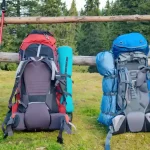

Camping and campfires often go hand in hand, but it’s important to practice sustainable campfire techniques to minimize our impact on the environment. As responsible campers, we should prioritize Leave No Trace principles, campfire safety, and alternative fire methods to ensure that we leave our campsite and the surrounding nature in pristine condition.
Leave No Trace Principles
Leave No Trace is a set of principles that promote responsible outdoor ethics, including campfire practices. By following these principles, we can minimize our impact on the environment and leave nature as we found it for future generations to enjoy. Here are the Leave No Trace principles related to campfires:
- Plan Ahead and Prepare: Before your camping trip, research and familiarize yourself with local regulations and guidelines for campfires. Check if campfires are allowed, if there are designated fire rings or fire pans, and if there are any fire restrictions in place.
- Campfires Only in Established Fire Rings or Fire Pans: When setting up a campfire, always use established fire rings or fire pans if provided. If not, use a fire-resistant container that is at least 200 feet away from lakes and streams, and away from vegetation.
- Use Small Sticks and Twigs for Fire Fuel: Avoid using large logs or branches for fire fuel, as they take longer to burn and can leave a larger impact on the environment. Instead, use small sticks and twigs that can be broken by hand.
- Burn Only Small sticks and twigs that can be broken by hand: Avoid burning larger sticks, logs, or trash, as they can take longer to burn and may not completely turn to ash. Burning small sticks and twigs that can be broken by hand ensures that the fire burns down to fine ash, which can be scattered after extinguishing the fire.
- Burn Only Small, Contained Fires: Keep your campfire small and contained, and avoid building large fires that can leave a bigger impact on the environment. A small fire is easier to manage and reduces the risk of spreading embers.
- Pack Out Burned Material: After extinguishing your campfire, let the ashes cool down, and then scatter the fine ash. Pack out any remaining burned material, including charcoal, foil, and food scraps. Do not bury or leave any trash in the fire pit.
Campfire Safety
Campfire safety is crucial to prevent wildfires and minimize the impact on the environment. Here are some campfire safety tips to keep in mind:
- Check for Fire Restrictions: Before starting a campfire, check for any fire restrictions or bans in the area. Follow all local regulations and guidelines for campfires.
- Clear the Area Around the Fire Pit: Make sure the area around the fire pit is clear of any flammable materials, such as leaves, grass, or overhanging branches. Create a fire-safe zone at least 10 feet in diameter.
- Keep a Bucket of Water and Shovel Nearby: Always have a bucket of water and a shovel nearby when you have a campfire. Use the water to fully extinguish the fire before leaving the campsite.
- Never Leave a Campfire Unattended: Never leave a campfire unattended, even for a short period of time. Always supervise the fire and make sure it is fully extinguished before leaving the campsite or going to bed.
- Extinguish the Fire Completely: When extinguishing the campfire, use water to douse the flames and stir the embers until there are no visible sparks or smoke. The fire should be cold to the touch before leaving the campsite.
- Use Alternatives to Campfires: Consider using alternative methods for cooking and warmth, such as a camp stove or a portable camping fire pit that uses propane or charcoal. These methods are generally safer and have less impact on the environment compared to traditional campfires.
Alternative Fire Methods
There are several alternative fire methods that can be used while camping, which are more sustainable and leave minimal impact on the environment. Here are some examples:
- Portable Camp Stove: A portable camp stove is a great alternative to traditional campfires for cooking food. They are lightweight, easy to use, and leave no trace behind. Look for camp stoves that are fueled by propane or butane, as these tend to burn cleaner and have less impact on the environment.
- Firestarter Cubes: Firestarter cubes are small, compact blocks that are made from recycled materials and are designed to ignite quickly and easily. They are a sustainable and convenient option for starting a campfire, as they do not produce harmful fumes or leave residue.
- Solar-Powered Lanterns or Flashlights: Solar-powered lanterns or flashlights are eco-friendly options for lighting up your campsite at night. They are powered by the sun and do not require any batteries, reducing the need for disposable batteries and minimizing environmental impact.
- Fireless Cooking Methods: Fireless cooking methods, such as using a thermal cooker or a haybox cooker, can be a sustainable and energy-efficient way to prepare food while camping. These methods use retained heat to cook food slowly, requiring less fuel and reducing the need for open flames.
By utilizing these alternative fire methods, we can reduce our carbon footprint, minimize the risk of wildfires, and leave no trace behind in our campsite.
Conclusion
In conclusion, sustainable campfire practices are crucial for protecting the environment and minimizing our impact while camping. By following Leave No Trace principles, practicing campfire safety, and exploring alternative fire methods, we can ensure that we leave nature untouched and preserve it for future generations to enjoy. Remember to always research and follow local regulations and guidelines for campfires, and consider using sustainable alternatives for cooking and warmth. Let’s do our part to protect the outdoors and make our camping experiences greener and more sustainable.
For more information on sustainable camping practices, visit here to learn about eco-friendly camping tips, gear, and practices to protect the environment while enjoying the great outdoors.
Author

Sarah Patel
Sarah is a travel writer and photographer, with a passion for exploring new destinations and cultures. She's traveled extensively throughout the world and has written for several major travel publications. Sarah is also an avid camper and outdoor enthusiast, and loves to combine her love of travel with her love of the outdoors. She's always on the lookout for unique and off-the-beaten-path campsites
Recent Posts


